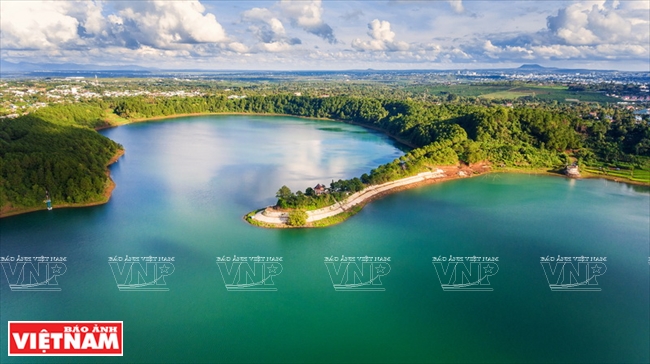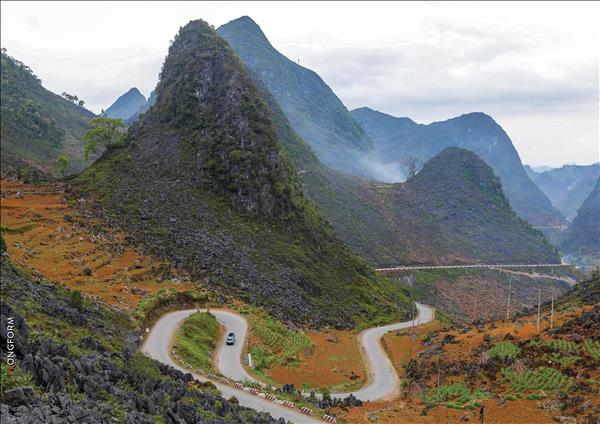A land of pristine beauty
Boasting beautiful natural scenery from lakes and waterfalls to mountains and forests, the central highlands province of Gia Lai is called a tourist site free of charge.
Visiting Gia Lai, you do not need to go far to find beautiful scenery. Right in its provincial capital, Pleiku, you can find scenic Bien Ho (Sea Lake), Bien Ho Che (Tea Sea Lake), Chu Dang Ya and Ham Rong volcanoes and Chu mountain.
All you need is a motorbike to drive around in Pleiku in the sun and wind of the central highlands to reach the best sightseeing places in town. You can enjoy the gorgeous view of Bien Ho with its cool and clear air or wander in immense green tea hills in Bien Ho Che. You can also see beautiful wild sunflowers dyeing yellow the sides of old volcanoes which have slept for millions of years, or enjoy the wild and dreamy beauty of rubber forests in their season of changing leaves.
For those who love adventurous trips, Kon Chu Rang and Kon Ka Kinh (an ASEAN heritage park) national parks are recommended. The parks, which are perfect for trekking and camping overnight, boast gorgeous waterfalls and wild animals and plants.
Not only endowed with pristine natural landscapes, Gia Lai is also a land imprinted with the cultural traits of the central highlands. The gong culture and old habits and practices of central highlands ethnic groups, including the Gia Rai, Ba Na, Mo Nong, Cho Ho, Xo Dang, E De, Chu Ru, S’tieng and Ro Mam, are the major attractions to this beautiful region.
Under the government’s development strategy for the central highlands, Prime Minister Nguyen Xuan Phuc stressed that the central highlands, including Gia Lai, must be a symbol of Vietnam’s tourism which carry the legendary and heritage traits of Asia in the 21st century.
Boasting beautiful natural scenery from lakes and waterfalls to mountains and forests, the central highlands province of Gia Lai is called a tourist site free of charge.
Visiting Gia Lai, you do not need to go far to find beautiful scenery. Right in its provincial capital, Pleiku, you can find scenic Bien Ho (Sea Lake), Bien Ho Che (Tea Sea Lake), Chu Dang Ya and Ham Rong volcanoes and Chu mountain.
All you need is a motorbike to drive around in Pleiku in the sun and wind of the central highlands to reach the best sightseeing places in town. You can enjoy the gorgeous view of Bien Ho with its cool and clear air or wander in immense green tea hills in Bien Ho Che. You can also see beautiful wild sunflowers dyeing yellow the sides of old volcanoes which have slept for millions of years, or enjoy the wild and dreamy beauty of rubber forests in their season of changing leaves.
|
Bien Ho (Sea Lake), a beautiful place not far from Pleiku. Photo: Thanh Hoa  Bien Ho is stunningly beautiful. Photo: Files Chu Dang Ya volcano and Chu Nam mountain range in the legendary bazan soil land of Gia Lai. Photo: Cong Dat . Inside Dong Xanh (Green Field) tourist resort in Gia Lai. Photo: Cong Dat Phu Cuong, one of beautiful waterfalls in Gia Lai. Photo: Files |
For those who love adventurous trips, Kon Chu Rang and Kon Ka Kinh (an ASEAN heritage park) national parks are recommended. The parks, which are perfect for trekking and camping overnight, boast gorgeous waterfalls and wild animals and plants.
Not only endowed with pristine natural landscapes, Gia Lai is also a land imprinted with the cultural traits of the central highlands. The gong culture and old habits and practices of central highlands ethnic groups, including the Gia Rai, Ba Na, Mo Nong, Cho Ho, Xo Dang, E De, Chu Ru, S’tieng and Ro Mam, are the major attractions to this beautiful region.
|
Young gong dancers from Ba Na ethic group perform in celebration of a new nha rong (communal house). Photo: Cong Dat Gia Lai has made great efforts in training young people to play gong to preserve and promote this heritage. Photo: Cong Dat Artisans in traditional costumes at a street carnival in Pleiku. Photo: Cong Dat |
Under the government’s development strategy for the central highlands, Prime Minister Nguyen Xuan Phuc stressed that the central highlands, including Gia Lai, must be a symbol of Vietnam’s tourism which carry the legendary and heritage traits of Asia in the 21st century.
The Prime Minister said the region should adopt a sustainable strategy for restoring the attractiveness of this epic land and promote tangible and intangible cultural values of central highlands ethnic groups.
A big producer of farm goods
The weather in Gia Lai was so nice in December, fully showing the beauty and prosperity of this bazan red soil region with red-ripening coffee plantations, immense green tea hills and rubber forests which are changing their leaves.
From the center of Pleiku, we went to the outlying districts of Chu Pah and Dak Doa on motorbikes and were stunned by the beauty of fruit-laden, red coffee plants ripening.
We visited Ngol village in Dak Doa town, Dak Doa district, and met Ho Thi Chau and her son who were busy grinding coffee. Pouring sacks of dry coffee into the grinding machine, the boy told us the coffee must be immediately ground after being dried to have the best taste.
|
Quality seedling gardens effectively help coffee growing in Gia Lai. Photo: Cong Dat Coffee varieties are produced with tissue-transplantation technology. Photo: Files A rubber plantation in Gia Lai. Photo: Thanh Hoa Coffee grown in Gia Lai and harvested on time has a premium taste. Photo: Cong Dat Happy smile of a coffee farmer for a bumper crop. Photo: Cong Dat The fertile bazan soil in Gia Lai is ideal for growing rubber, coffee and pepper. Photo: Cong Dat Gia Lai is regarded as the rubber capital of the central highlands with 120,000 hectares growing rubber trees. Photo: Thanh Hoa Immense tea fields in Bien Ho Che (Tea Sea Lake), Chu Pah district. Photo: Thanh Hoa |
This year, Ho Thi Chau does not have to worry about the outlet for her 20-ton harvest because Vinh Hiep company, a large coffee company in Gia Lai, has contracted to buy them all.
Apart from coffee, Gia Lai is a major grower of tea, rubber and pepper. In the Bien Ho Che area in Chu Pah, around 13 kilometers from Pleiku, there are vast tea hills with a total area of more than 1,100 hectares. The area was originally the French’s first tea plantation in Gia Lai in the 1920s. Gia Lai’s Bien Ho tea is a well-known brand which has received a certificate of high-quality Vietnamese farm produce by the Ministry of Agriculture and Rural Development. The tea is currently exported to Australia, Afghanistan, Pakistan and Singapore.
Gia Lai is also considered the rubber capital of the central highlands. The province has nearly 120,000 hectares of rubber with an annual output of nearly 290,000 tons of latex, which accounts for more than 30% of the country’s total output and quadruples the total output of the four remaining central highlands provinces.
Walking in huge rubber forests where the trees are changing their leaves in Dak Doa district, we could see Gia Lai’s big potential for the so-called “white gold”.
Gia Lai is now a major producer of farm goods in the central highlands, ranking second in the region in farming area with over 500,000 hectares of different crops. These include 120,000 hectares of rubber, 94,000 hectares of coffee, 17,000 hectares of cashews and nearly 17,000 hectares of black pepper.
Party General Secretary Nguyen Phu Trong on his working visit to Gia Lai in 2017 asked the province to take advantage of its agro-forestry production to develop a high-level commodity agriculture associated with the processing industry, which should connect the state, scientists, entrepreneurs and farmers, while protecting the forests and eco-environment.
Given these orientations, Gia Lai aims to develop a green economy where investment is attracted selectively not at the cost of the environment. The province is set to develop organic agriculture, and apply hi-technology to ensure sustainable economic growth. It also encourages big groups and enterprises to invest in hi-tech agricultural products and increase connections with farmers to support them in production.
With proper sustainable development strategies and solutions and the determined spirit of ethnic groups in Gia Lai, the legendary land of bazan red soil is believed to soon become a region worth living in, in the central highlands.
| Gia Lai has a total area of 15,500 km2 and is the second largest province in the country, and the largest in the central highlands. The province has the climate and soil conditions favorable for growing industrial crops such as coffee, rubber and pepper. With a population of over 1.4 million, including 34 ethnic groups with diverse and rich cultures and beautiful pristine scenery, Gia Lai has the advantages for developing tourism. |
Story: Thanh Hoa - Photos: Cong Dat,Thanh Hoa & Files







